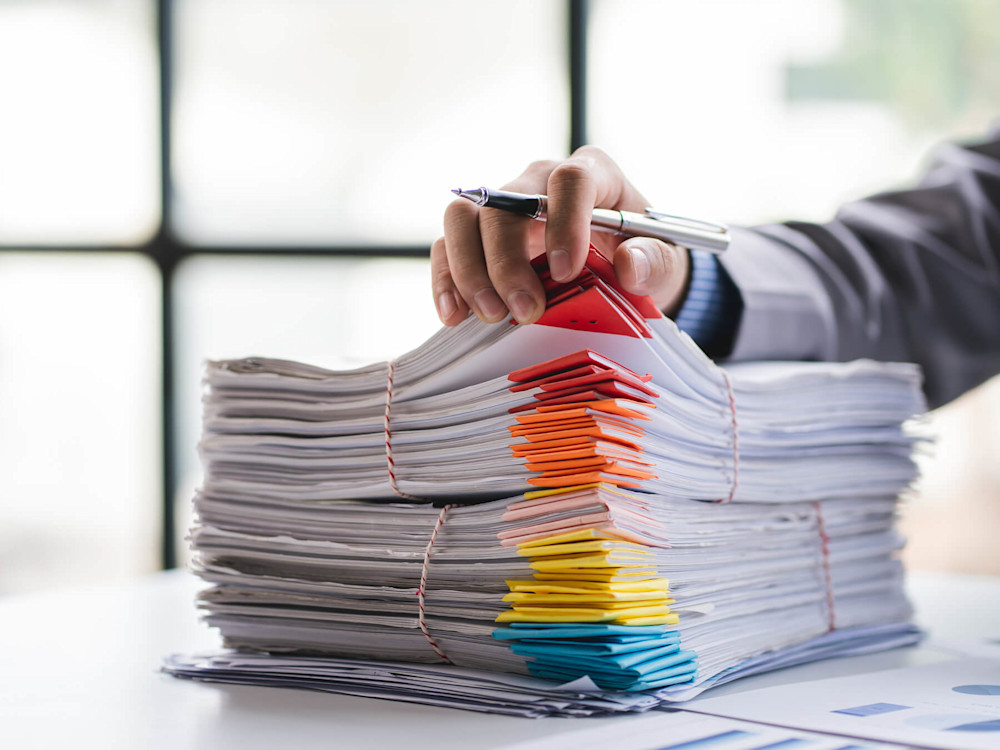How to Select the Ideal Resume Paper Quality

You only have one chance to make the right first impression. Hiring managers spend just seven seconds looking at each resume that lands on their desks. That is a tiny window of opportunity. In that time, you need to hook their attention and convince them that you’re worth a second look.
While there are many ways that you can make sure your resume hits the mark, one that you must not overlook is the resume paper you use. Choosing the right type of material for your needs could help elevate your next application. If you have no clue where to start, you have come to the right place. In this guide, we will cover how to select the ideal resume paper quality.
What is “resume paper,” anyway?
If you’ve always printed your resume on plain paper, you might want to change your ways. To get ahead of the competition, it’s worth taking things to a new level. Using specific resume paper – rather than uncoated paper – will show that you are willing to go above and beyond.
As we will cover in this guide, there is a wide variety of types of resume paper, each with a different purpose. It’s important that you know your stuff before you try to choose the right one for your needs. There’s a selection of colors, weights, sizes, and materials you can use.
Why should you use resume paper specifically?
Before we delve into the different types of resume paper that you might want to consider, let’s talk about why you may want to do it. It’s true that most people simply use standard printer paper. However, here are some of the advantages to resume paper you should consider:
Professionalism. Whenever you’re applying for a job, the main aim is to look professional. You want to show the hiring manager that you are serious about the role at hand. When you submit an application printed on resume paper, it shows that you are a cut above the rest. Printing on resume paper rather than printer paper is a simple approach that may make all the difference here.
Readability and quality. Accidents happen in the world of printing. When you are using standard printing paper, there’s a higher chance of things going amiss. For example, you might find that the quality of the print is bad (making it hard to read!) or that the ink has bled. Using resume paper instead means that you get a higher-quality document.
Become instantly memorable. In a sea of resumes, you need to work extra hard to be memorable. Should the hiring manager receive hundreds of applications on standard paper, using resume paper is a quick way to catch their attention. So long as you select a paper type that is formal and works for the industry, you should be a winner.
While you don’t have to use specific resume paper when applying for jobs, it might just help. You want to get ahead, and that means using everything in your arsenal to hook the reader. You can look for a wide range of resume paper online and see which one suits you.
When should you use fancy resume paper?
Next up, let’s talk about when you might want to use fancy resume paper. Of course, you can use this type of printing paper whenever you please. However, there are some scenarios in which you might want to use a special type of resume paper. Here’s a quick look:
Submitting an application via mail. These days, many companies accept email applications. However, if you are going to the effort of sending your resume via post, you might want to use resume paper. The quality of the paper is certain to stand out here.
Attending a career fair. Are you heading to a career fair? If you are hoping to pass your resume out to a selection of recruiters, you need to be strategic. Choosing to use special resume paper – rather than standard printing paper – will help you along the way. When a recruiter has hundreds of resumes to review, yours will be the best quality.
Networking events. Networking events are all about making a quick impression on people. You might already have some business cards under your belt, but why stop there? Printing out your resume on quality paper gives you yet more marketing materials. Be selective about who you give your resume to and who you don’t.
Interviews. In some cases, it may be worth bringing copies of your resume to an interview. For instance, if a selection of professionals will be interviewing you (as in a panel interview), you can make sure that each one can see your credentials. In this scenario, it’s worth making sure that you use the best resume paper.
The small details matter more than you might think. When you’re competing against a whole horde of other candidates, it’s important to get every touch right. For that reason, you may want to use resume paper that accurately reflects your high level of professionalism and value.
Different types of resume paper
Unless you’re an expert in paper types, you might need some more information. There’s certainly an art to choosing the right type of resume paper for your application. First, right off the bat, we’re going to start by looking at the various materials that you may choose. While there’s a rainbow array of options out there, here are some of the most popular you may consider:
Uncoated paper
First up, is the standard printing paper. You likely already use this in your home or office when you are printing out documents for everyday needs. Uncoated paper is exactly that. It is a normal printing paper that you can buy in bulk.
This specific type of printing paper works well for medium ink as it tends to absorb it well. However, it’s nothing special. This is the type of resume paper that will not help you stand out.
Recycled paper
Looking for a way to flex your eco muscles? Using recycled resume paper may be the answer. You will usually find that this type of paper is made up of between 60% and 100% recycled paper pulp. It may work if you’re applying for a role in the sustainability sector.
If you happen to use recycled granite paper, there is a trademark look here. You will find that there are small gray and black speckles on the sheet itself. Make sure that these marks don’t detract from the content of your next resume.
Linen paper
Linen is one of the most used types of resume paper out there, and for good reason. This material tends to be thicker than its competitors and looks highly professional. The hiring manager will quite literally be able to feel the difference when you use this type of paper.
Parchment paper
Parchment paper is high-level and often used for official documents, such as diplomas or degrees. In some cases, you may find that this type of resume paper works well for you.
However, resumes that include colorful elements may not look great on this paper. That is because the marbled effect of the resume paper can make the tones less visible. Only use this paper when you have created a resume that is completely black and white.
Cotton paper
Cotton is likely the best resume paper. This material is soft to the touch but durable, making it an ideal choice. If you do decide to choose this type of paper, pay close attention to the percentage of cotton in it. Spoiler: It can vary massively. The higher the percentage of cotton the paper has, the more high-quality it will appear to the hiring manager.
Which resume paper material should you choose?
As a general rule, we recommend not using standard printing (or uncoated) paper. Cotton is one of the best choices you can make, followed closely by the likes of linen resume paper. If you want to make the right impression on the hiring manager, you should use one of these.
Only use recycled (or granite) resume paper if you are trying to make a statement. For example, if the company has a strong sustainability arm and you want them to notice you, you might use it. Finally, be wary of using parchment. While it is a professional paper, it is also a tricky one to get right. You don’t want to end up making your resume hard for the hiring manager to read.
Should resume paper be white or ivory?
Now that you know which resume paper material you want to use, let’s talk about the color. There are two main options that are professional here: ivory and plain white. Let’s take a look at each of them and determine when you might want to use each for your next application.
White resume paper
Plain white resume paper is the safest option. That is because all of the elements of your resume will look crisp and clear on this color. You don’t have to worry about parts of your application being hard to read when you opt for this one. What’s more, you will find that most of the resume paper types we have listed above are available in a sharp, white tone.
Ivory resume paper
Looking for something a little fancier? You might want to try using ivory resume paper instead. If you are using super high-quality paper, you will find that this color looks professional and classy. Of course, should you choose this tone, it’s important that you test it out first. Print out your resume using this paper and make sure that everything on the page is clear and legible.
Choosing the right weight for your resume paper
Let’s address another question that may be on your mind. What weight is resume paper? Your everyday printing paper comes in at around 20 lbs per ream. However, when you are choosing quality resume paper, you should make sure that the weight comes in a little higher than that.
Since you are going for premium resume paper, you should choose between 24 lb and 32 lb options. These are the standard ones that are likely to be available. Of course, the higher the weight, the thicker the paper will be. Keep that in your mind when you’re choosing yours.
How to pick the best size for your resume paper
Messing around with the size of paper you use is a mistake. While there’s room for flexibility when it comes to the material, weight, and color, you need to keep the size uniform. A standard resume paper size is 8.5 inches by 11 inches. Make sure that you go with this option.
Expert printing tips when using resume paper
If you’ve made it to this point, you should be feeling pretty confident about choosing the right resume paper. Before you rush off to print your application, here are some tips to remember.
Always do a test run. Whenever you’re printing your resume, always do a test run. Printers can make silly mistakes that will ruin your chances of landing an interview.
Leave space around the edge. When designing your resume, be sure to leave space around the edges. That way, nothing will get cut off in the printing process. You may find that using a resume paper template will help you get this part of the job right.
Check your resume first. Once you have the finished product, be sure to check it. Make sure that everything is up to scratch before sending it to a hiring manager.
The right resume paper wins interviews
Choosing the best resume paper for your application doesn’t have to be a challenge. Keep in mind that readability is your number one priority here. Use our guide to help you select the perfect paper for your needs, and always check the print quality before you send it out there.
Your resume is marketing material – it needs to show you in the best light. When you’ve chosen the best resume paper, check that the content is on point. Submit it for a free resume review now. Our experts will give you the feedback you need to succeed.

